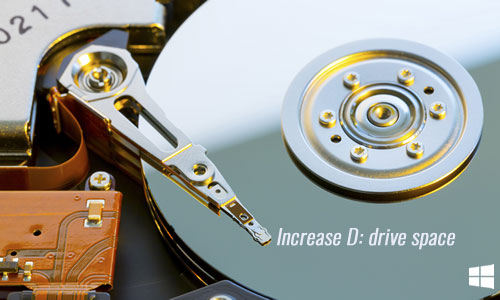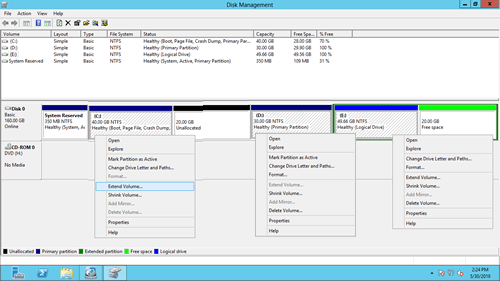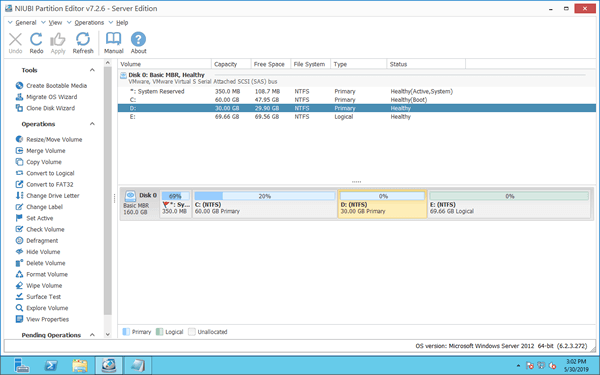In many servers, the system C: drive becomes full while there is plenty of free space in other partitions, such as D. However, in some servers, the D drive may also run out of space. Is it possible to increase a partition's size without reinstalling programs or restoring from a backup? The answer is yes. This article explains how to increase D drive space in Windows Server 2012/2016/2019/2022. It also provides three methods to extend D drive in Windows Server 2012 R2 without losing data.

Method 1: extend D drive with Disk Management
Windows Server 2012 and subsequent versions have Disk Management to help shrink and extend partition. However, because of many restrictions, it is not the best choice. To extend D drive in Server 2012/2016/2019/2022 via Disk Management, disk partition configuration must meet the requirements:
- D drive must be formatted with NTFS.
- There must be adjacent unallocated space on the right side of D.
If you don't use third party software, to get adjacent unallocated space, you must delete the partition on the right D. There is 'Shrink Volume' function in Disk Management, some people may ask why not shrinking D drive.
As you see in my server, Extend Volume is disabled for D: drive after shrinking both partition C: and E, this is because:
- 'Shrink Volume' can only shrink partition towards left and make unallocated space on the right side.
- 'Extend Volume' can only merg unallocated space to the adjacent partition on the left.
If D is FAT32 or there is no other partition on the right side. Disk Management is useless.
Method 2: increase D drive space from C or E
To increase D drive space in Server 2012 R2/2016/2019/2022, third party software such as NIUBI Partition Editor is better choice.
- It can release unallocated space on either left or right while shrinking a volume.
- It can merge unallocated space to either adjacent partition by 1 step.
- It can move unallocated space and combine to nonadjacent partition on the same disk.
There are many disk partition software options available in the market, but few are truly safe. Resizing partitions carries a potential risk of system and partition damage. It's strongly recommended to back up or clone your disk partition before proceeding and to use reliable partition software. NIUBI Partition Editor stands out as a safer and faster choice compared to other software, thanks to its innovative technologies.
- Virtual Mode: To prevent mistakes, all operations are listed as pending for preview. Real disk partitions are not changed until you click "Apply" to confirm.
- Cancel-at-will: If you apply incorrect operations, you can cancel ongoing tasks without worrying about partition damage.
- 1 Second Rollback: If any error is detected while resizing partitions, the software can automatically revert the server to its original state in an instant.
- Hot Clone: Clone disk partitions without interrupting the server. You can clone the system disk before making changes or as part of a regular backup routine.
- Advanced File-Moving Algorithm: Resize and move partitions 30% to 300% faster, saving significant time, especially when handling a large number of files.
Download NIUBI Partition Editor and you'll see all disk partitions with structure and other information in the main window.
Available operations to highlighted disk or partition are listed on the left or by right clicking. You just need to drag and drop on the disk map to resize disk partitions.
Follow the steps to increase D: drive space in Windows Server 2012 from C or E:
As long as there is free space in other partitions on the same disk, you can transfer to partition D. Operating System, program, Windows services and associated settings, as well as anything else keep the same with before.
If you use any types of hardware RAID arrays, VMware or Hyper-V, the steps to resize virtual partitions are the same.
Method 3: increase size of partition D with other disk
In some servers, there is not enough free space in other partitions. In that case, no partitioning software can add space from another separate disk. The separate disk means Disk 0, 1, etc. that are shown by NIUBI or Disk Management.
Follow the steps to increase size of D: drive in Windows Server 2012 R2 with other disk:
No matter how your disk partitions are configured, NIUBI Partition Editor can help you increase D drive space in Server 2012/2016/2019/2022 without data loss. Select the corresponding method according to your own disk partition structure.



